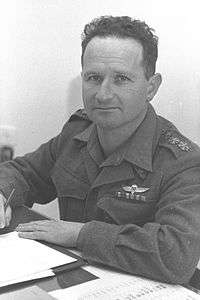Uzi Narkiss

Uzi Narkiss (Hebrew: עוזי נרקיס; January 6, 1925 – December 17, 1997) was an Israeli general. Narkiss was commander of the Israel Defense Forces units in the Central Region during the Six Day War. Narkiss appears in the famous photograph of Defense Minister Moshe Dayan flanked by Chief of Staff Yitzhak Rabin and himself, taken in the Old City of Jerusalem shortly after its capture from Jordanian forces in the 1967 Six Day War.[1]
Biography
Uzi Narkiss was born in Jerusalem to Polish Jewish parents. His first memory was of going into hiding during the 1929 Arab riots. Narkiss attended high school at Gymnasia Rehavia. He joined the Palmach at the age of 16[2] and was involved in Haganah operations against British Mandatory forces in Palestine.
Military career
.jpg)
In April 1948, Narkiss headed the assault on Katamon, capturing the monastery at San Simon — a key strategic position. Following the final departure of the British and the Israeli Declaration of Independence, Narkiss was appointed to assist those besieged in the Jewish Quarter of the Old City. Narkiss' unit succeeded in penetrating Zion Gate, bringing in supplies and evacuating the wounded from those under siege. When military reinforcements failed to appear, however, Narkiss ordered his men to retreat, with the Old City falling to Jordanian forces shortly thereafter.
Narkiss spent several years in France during the formative years of Israel, seconded to study at the École de Guerre (the French Military Academy) and later in the capacity of Israeli military attaché, having been awarded the Légion d’honneur by the French government. Narkiss returned to Israel to continue his military career and in 1965 became the first director of the Israel National Defense College.
In June 1967, with seven brigades under his command, Narkiss was responsible for combating any possible Jordanian offensive. Capturing the Old City was not part of the plan. Israeli units moved effectively to take key positions in east Jerusalem, where one key location was Ammunition Hill. Still, to Narkiss' dismay, the politicians would still not allow the Old City to be taken. But with a looming cease fire approaching after an emergency meeting of the UN, Moshe Dayan gave the order to Narkiss who quickly capitalised on the opportunity to capture the city before any cease fire prevented this as an option. Under his direction, the Old City was captured and Jerusalem reunified under Israeli control. From Narkiss' viewpoint, this completed the campaign he had begun nineteen years earlier, and whose previous failure had haunted him.
After the 1967 six day war the Palestinian village of Beit Awwa was completely destroyed.[3] Moshe Dayan claimed the destruction was carried out under the orders of an officer who wished to expel the residents, Brigadier General Uzi Narkiss claimed the credit for the action.[4]
Narkiss retired from the IDF in 1968, subsequently holding key positions in the Jewish Agency and the World Zionist Organization. In 1948 Uzi Narks searched the body of the dead Palestinian commander Abdul Kader Husseini for his Koran on the battlefield. In the 1980s he wanted to give it to Kader's son Faisal Husseini but only "in the presence of journalists and TV cameras – otherwise I am not interested". Husseini was not interested under such terms, therefore Narkiss kept it in his library.[5]
He died in Jerusalem at the age of 72.
References
- ↑ Poster of Uzi Narkiss
- ↑ A Defender of Jerusalem, Jerusalem Post supplement by Greer Fay Cashman (partial interview with Narkiss) Archived April 10, 2005, at the Wayback Machine.
- ↑ UN Doc A/8389 of 5 October 1971 A/8389 of 5 October 1971. Para 57. in the Sunday Times (London) on 11 October 1970, where reference is made not only to the villages of Jalou, Beit Nuba, and Imwas, also referred to by the Special Committee in its first report, but in addition to villages like Surit, Beit Awwa, Beit Mirsem and El-Shuyoukh in the Hebron area and Jiflik, Agarith and Huseirat, in the Jordan Valley. The Special Committee has ascertained that all these villages have been completely destroyed. Para 58. the village of Nebi Samwil was in fact destroyed by Israeli armed forces on March 22, 1971.
- ↑ Segev, 2007, p. 409
- ↑ Husseini's Koran
External links
- General Uzi Narkiss - A historic radio interview with General Uzi Narkiss on June 7 - one day after the Six-Day War, describing the battle for Jerusalem
- Central Zionist Archives in Jerusalem site. Office of Uzi Narkiss (S91)